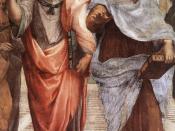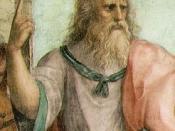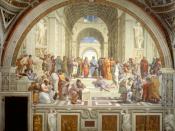Throughout history many art movements have emerged that artists and styles can be classified under. One large distinguishable movement was that of the Italian Renaissance. The Renaissance is categorised as the period between c. 1450 and c.1600. This period saw great development in our art history, and the recognition of many master talents. The various stages of the Renaissance saw a certain growth towards modernity, that can be illustrated with the consideration of artwork from the Early and High Renaissance paintings such as Masaccio's: The Holy Trinity and Raffaelo's: School of Athens.
The Early Renaissance in Florence was a turbulent time that brought forth some of the most memorable and timeless pieces known to the Western World. Masaccio depicted art much unlike anything proceeding it because it incorporated emotions and feelings. The 1400's as Stirton expresses are said to be the beginning of beautiful attitudes, movements, liveliness and vivacity.
The use of bright colours and revolutionary painting techniques highlighted deep threads of concern for humanist learning and naturalistic thoughts within the society. The application of scientific perspective and the depiction of natural lighting were also an important step towards the development of modernistic painting.
Masaccio's paintings held a firm grasp of humanistic values. Humanists of this era sought "to breathe life into the dimmed legacy of Greece and Rome, a legacy that was locked in texts and monuments." Humanists everywhere emersed themselves in the "written wisdom of classical antiquity," to study the languages of Greek and Latin, peruse classical literature and engage in history and pre-Christian philosophy. "The chief concerns of humanism were human values and interest as distinct from- but not opposed to- the other worldly values of religion." Humanistic values are observed in Masaccio's painting of The Holy Trinity in the emotions, feelings and bright colours; the...


